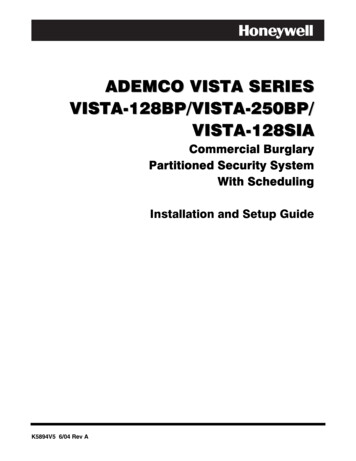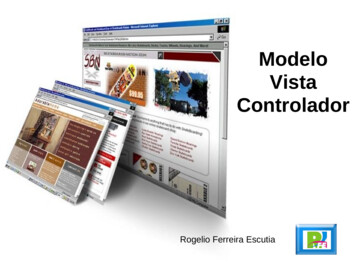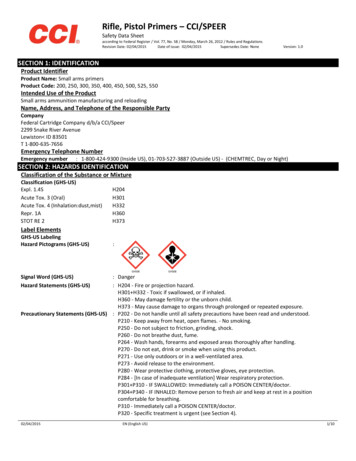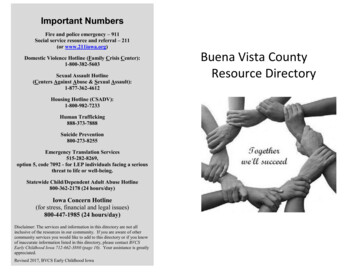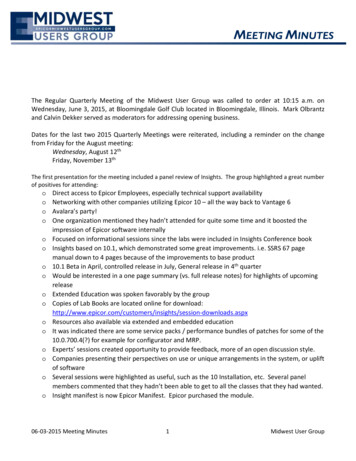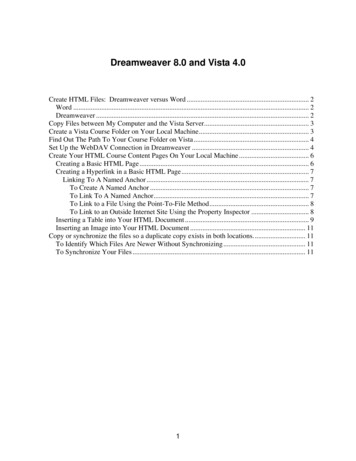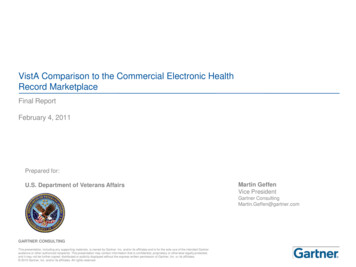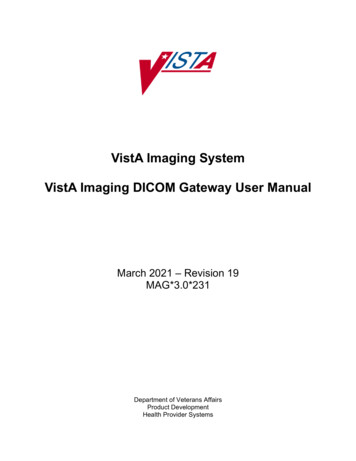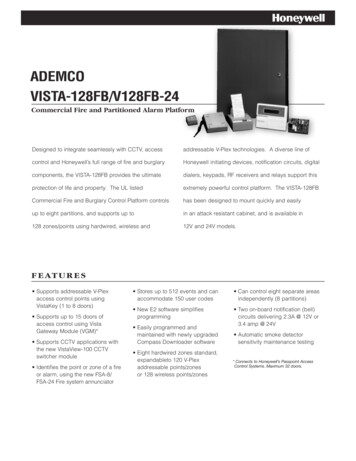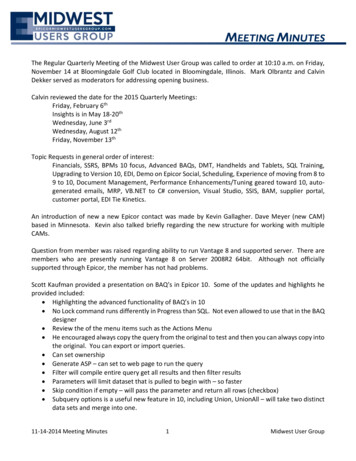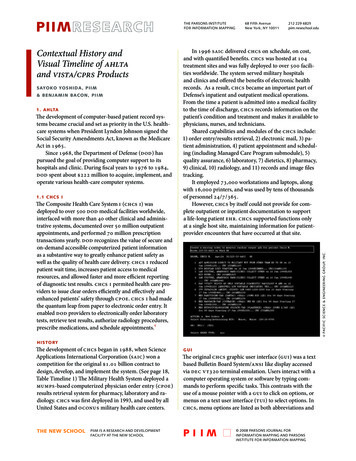
Transcription
PIIMTHE PARSONS INSTITUTEFOR INFORMATION MAPPINGSayo k o Y o shi da, PI I M& Ben j ami n Baco n , PI I M1 . A H LTAThe development of computer-based patient record systems became crucial and set as priority in the U.S. healthcare systems when President Lyndon Johnson signed theSocial Security Amendments Act, known as the MedicareAct in 1965.Since 1968, the Department of Defense (DOD) haspursued the goal of providing computer support to itshospitals and clinic. During fiscal years to 1976 to 1984,DOD spent about 222 million to acquire, implement, andoperate various health-care computer systems.1 . 1 CH CS IThe Composite Health Care System I (CHCS I) wasdeployed to over 500 DoD medical facilities worldwide,interfaced with more than 40 other clinical and administrative systems, documented over 50 million outpatientappointments, and performed 70 million prescriptiontransactions yearly. DoD recognizes the value of secure andon-demand accessible computerized patient informationas a substantive way to greatly enhance patient safety aswell as the quality of health care delivery. CHCS I reducedpatient wait time, increases patient access to medicalresources, and allowed faster and more efficient reportingof diagnostic test results. CHCS I permited health care providers to issue clear orders efficiently and effectively andenhanced patients’ safety through CPOE. CHCS I had madethe quantum leap from paper to electronic order entry. Itenabled DoD providers to electronically order laboratorytests, retrieve test results, authorize radiology procedures,prescribe medications, and schedule appointments.1212 229 6825piim.newschool.eduIn 1996 SAIC delivered CHCS on schedule, on cost,and with quantified benefits. CHCS was hosted at 104treatment sites and was fully deployed to over 500 facilities worldwide. The system served military hospitalsand clinics and offered the benefits of electronic healthrecords. As a result, CHCS became an important part ofDefense’s inpatient and outpatient medical operations.From the time a patient is admitted into a medical facilityto the time of discharge, CHCS records information on thepatient’s condition and treatment and makes it available tophysicians, nurses, and technicians.Shared capabilities and modules of the CHCS include:1) order entry/results retrieval, 2) electronic mail, 3) patient administration, 4) patient appointment and scheduling (including Managed Care Program submodule), 5)quality assurance, 6) laboratory, 7) dietetics, 8) pharmacy,9) clinical, 10) radiology, and 11) records and image filestracking.It employed 73,000 workstations and laptops, alongwith 16,000 printers, and was used by tens of thousandsof personnel 24/7/365.However, CHCS by itself could not provide for complete outpatient or inpatient documentation to supporta life-long patient EHR. CHCS supported functions onlyat a single host site, maintaining information for patientprovider encounters that have occurred at that site. Pacific S cience & Engineering G roup, I nc.Contextual History andVisual Timeline of ahltaand vista/cprs Products68 Fifth AvenueNew York, NY 10011H isto ryThe development of CHCS began in 1988, when ScienceApplications International Corporation (SAIC) won acompetition for the original 1.01 billion contract todesign, develop, and implement the system. (See page 18,Table Timeline 1) The Military Health System deployed aMUMPS-based computerized physician order entry (CPOE)results retrieval system for pharmacy, laboratory and radiology. CHCS was first deployed in 1993, and used by allUnited States and OCONUS military health care centers.PIIM IS A RESEARCH AND DEVELOPMENTFACILITY AT THE NEW SCHOOLGU IThe original CHCS graphic user interface (GUI) was a textbased Bulletin Board System/ANSI like display accessedvia DEC VT320 terminal emulation. Users interact with acomputer operating system or software by typing commands to perform specific tasks. This contrasts with theuse of a mouse pointer with a GUI to click on options, ormenus on a text user interface (TUI) to select options. InCHCS, menu options are listed as both abbreviations and 2008 PARSONS JOURNAL FORINFORMATION MAPPING AND PARSONSINSTITUTE FOR INFORMATION MAPPING
PIIMphrases. For example, “CLN Clinical System Menu” and“PHR Pharmacy System Menu.” User could select menususing curser, and identify the position in the screen withhighlight. Text based display is useful when a large vocabulary of commands or queries, coupled with a wide (orarbitrary) range of options, can be entered more rapidly astext than with a pure GUI. For the text monospaced Terminal bitmap font was used in white on black background.In terms of feedback/alert system, when certain datatype or menu option is not available, the screen givesa user warning. It appears next to a menu option. Forexample, “WAM Workload Assignment Module Menu(Not Available).”According to Government , the “inpatient order-entrycapability in CHCS was not considered user-friendly bymany physicians because entering conditional and complex orders into CHCS took much more time than writing out the orders by hand. As a result, many physiciansresisted using the inpatient order-entry features of CHCS,electing to write out their orders by hand and to haveother staff enter them into the system.”1 . 2 A H LTA / CH CS I IThe DoD is currently in the process of fielding CHCS II.CHCS II is a windows-based application that further enhances CHCS capabilities and provides a user-friendly interface with improved coding and expanded documentationof medical care. It is an enterprise-wide medical clinicalinformation system that maintains and provides worldwidesecure online access to comprehensive patient records,continuing the Department’s military EMR effort. Withthis system, doctors and other medical workers can createand add to electronic medical records for the individualsthey treat. CHCS II is secure, standards based, and patientcentric, for use in our garrison based medical facilities toour forward deployed medical units. CHCS II is a core component of military medical readiness, supporting uniform,secure, high-quality health care delivery and continuity ofcare to Military Health System beneficiaries. By streamlining and computerizing business processes and schedulingsystems, CHCS II stresses a team-based approach to healthcare and will improve hospitals and clinics’ efficiency inproviding timely service to patients. Additionally, efficient,secure, and readily accessible communication among providers improves the continuity of care and increases patientsafety and the timeliness of diagnoses and treatments. CHCSII meets the eight care delivery functions identified bythe Institute of Medicine as essential for electronic healthrecords to enhance safety, quality and efficiency of healthcare delivery. It centrally stores all electronic patient medi-P IIM R ESEA R C HP U BLISH ED OC TOBER 30, 2008[page 2 ]Contextual History and Visual Timelineof ahlta and vista/cprs ProductsSayoko Yoshida, PIIM & Benjamin Bacon, PIIMcal records in the Clinical Data Repository (CDR). CHCS IIhas received approval for full rate production and beganworldwide deployment in January 2004.2In 1996 DoD began developing CHCS II to replaceCHCS. It was first deployed to a military MTF in May 2003when the Army and the Air Force brought their first twomajor medical facilities online.CHCS II was renamed Armed Forces Health Longitudinal Technology Application (AHLTA) in 2005. AHLTAwas introduced to address the limitations of the old CHCSMUMPS-based system, which had over 100 regional and local servers that did not communicate with each other, andhad little to no interaction between the various services.AHLTA builds on capabilities of existing systems,phasing in their functions over time, while adding newcapabilities to met mission requirements. AHLTA initiallyprovides support capabilities in the outpatient arena,while the mature system will extend those capabilitiesinto the inpatient arena. The ultimate goal is to integrateall legacy CHCS clinical functions, as well as the functionsof other clinical applications, into AHLTA. The system hasincorporated many commercial off-the-shelf EMR software features, such as the MEDCIN clinical database andcommercially available ICD-9 coding functions.DoD had deployed AHLTA to 118 of 138 plannedMilitary Treatment Facilities. DoD employed BEA Tuxedo,Sun (SeeBeyond) eGate, ESI and M/Objects, and ProxicomDaou Systems Enosus to synchronize applications and datain the 104 CHCS legacy host sites with the AHLTA clinicaldata repository (CDR), using HL7 messaging. Synchronization is accomplished in a manner that provides semanticinteroperability, and ensures continuous high availabilityand reliability. DoD undertook a significant mapping effort to ensure that the many different medical terms in the104 CHCS host sites are completely computer-processablein the AHLTA CDR, and that this data is maintained innear real time.DoD planed to wrap the CHCS Massachusetts GeneralHospital Utility Multi-Programming System (MUMPS)code in InterSystems Caché, which combines objects andSQL, eliminates object-relational mapping, and enablesrapid Web application development, excellent transactionprocessing speed, scalability and real-time queries againstthe transaction database.AHLTA is being deployed in a phased approach, using blocks of functionality. When complete, AHLTA willprovide a comprehensive longitudinal health record for9.2 million DoD beneficiaries it will directly supportDoD Access to Care, Population Health and Force HealthProtection objectives. 2008 PARSONS JOURNAL FORINFORMATION MAPPING AND PARSONSINSTITUTE FOR INFORMATION MAPPING
PIIMC hallen g esWhen the 104 CHCS sites were initially established, therewere no standards established for medical terminology, and no controlled medical vocabulary (CMV). Forexample, the following constructs were present in the 104CHCS host sites.Establishing the CDR was the key to providing semantic interoperability, where information exchange wascompletely computer-processed. While standard HL7 2.4messaging can handle the conversion of various files fromone structural format to another, more sophisticated techniques are required to ensure that terms mapped from onesystem mean the same in the other system. The CDR andCMV, provided by the 3M Care Innovations Suite, includethe 3M Health Data Dictionary (HDD), which works inconjunction with the MEDCIN terminology engine to provide semantic interoperability. AHLTA automates evaluation and management coding for injuries, conditions anddiseases, using ICD-9 and CPT-4 codes.It was understood that CDR had to permanently storedata from many sources, be able to handle data in manyformats (images, text, XML), and enable finely structured,explicitly coded data to support bio-surveillance effortsand cross-patient analysis of data for patient safety, qualityand research purposes.DoD populated the CDR initially with 25 months ofhistorical normalized lab, pharmacy and radiology datafor each patient, which was transmitted from each CHCShost site. This data is now synchronized with the CDR innear real time through distributed transaction processingtechnologies and interface engines such as Sun (SeeBeyond) eGate, BEA Tuxedo, and development methodologies employing M/Objects, ESI Objects and ProxicomDaou Systems Enosus.A Terminology Service Bureau added SNOMED codingand Problem Knowledge Coupler, Inc., terms to furtherenhance semantic interoperability. The ultimate goal wasto create a CDR and CMV that were compliant with theHL7 3.0 Reference Information Model.Contextual History and Visual Timelineof ahlta and vista/cprs ProductsSayoko Yoshida, PIIM & Benjamin Bacon, PIIMmilitary’s functional capabilities, scalability requirementsand three-tiered technical architecture. In addition, DoDknew that the CDR was the foundation for providing all ofthe components of an EHR: clinical documentation anddisplay, workflow and decision support.A HLTA B l o c ksAHLTA Block I deployment began January 1, 2004. Thesystem permit clinicians to enter outpatient clinicalencounter documentation via clinical workstation at thepoint of care, using a common presentation layer acrossthe enterprise.The interface was engineered using Visual Basic, andwas based on the Microsoft Style Guide. The interfacelooked similar to Microsoft Outlook, providing clinicianswith a picture of scheduled patients for their workday andactions required. Clinicians could prepare an electronic“SOAP note” using the MEDCIN terminology engine. BlockI also provided automated clinical practice guidelines, anda complete set of alerts for medical complications andpreventive health care promotion. Block I deployment wascompleted December 1st, 2006.Block II began June 1, 2005, and will add 6,371 users,and will provide optical order entry for the productionof military spectacles at military fabrication laboratories,and an electronic dental charting application. Subsequentreleases may add up to 21,575 users, provide inpatientand emergency services, and expand laboratory, pharmacyand radiology capabilities. Block II is scheduled to becompleted January 1, 2010.Deployment of Block III began in January 1, 2007.Block III includes enhancements to AHLTA by replacinglegacy functionality including the pharmacy, laboratoryand anatomic pathology, radiology, inpatient chartingand documentation, occupational health and surveillancemodules. Block III is scheduled to be completed September 1, 2011.Fiscal a n d Te ch n ical Co n st r ain tsAHLTA has been built using incremental developmentand delivery of blocks of functionality based on serviceoperational priorities, and funding available through theProgram Objective Memorandum budget process.Because of the size of this project, a phased approachwas required, as all funding was not available immediately. The 1996 decision to interface CHCS with AHLTAwas also supported by the unavailability of a commercialoff-the-shelf EHR technology that could support theP IIM R ESEA R C HP U BLISH ED OC TOBER 30, 2008[page 3 ] 2008 PARSONS JOURNAL FORINFORMATION MAPPING AND PARSONSINSTITUTE FOR INFORMATION MAPPING
PIIMContextual History and Visual Timelineof ahlta and vista/cprs ProductsSayoko Yoshida, PIIM & Benjamin Bacon, PIIMMC4, www.mc 4.army.milGUIScreen of the CHCS II interfaceM C 4 , www. mc4 . army. milIn 1996, as part of the Clinical Integrated Workstation,Defense began building a prototype GUI to improve orderentry capability of CHCS. The goal of this prototype is toenable physicians to access computer screens or windowscontaining icons that represent activities such as orderingor modifying patients’ prescriptions, and ordering inpatient laboratory tests.The goal of CHCS II GUI was to allow physicians tolook up inpatient data, review inpatient laboratory testresults, and perform many other tasks by clicking on a fewicons and selecting items from a few menus. The goal wasto enable physicians to use CHCS more efficiently; therebyreducing the possibility of errors in the system due todata-entry mistakes and reducing costs associated withhaving other staff enter physicians’ orders.CHCS II incorporates information that used to berecorded on paper charts, primarily notes by doctorsand nurses. CHCS II incorporates those documents intothe patient’s electronic health record. Clinicians can useexisting templates to make notes and track treatments ona variety of illnesses or conditions, or they can create theirown forms. (Bob Brewin)AHLTA version 1.1 was released in January 2006. Tothe right is a screenshot of AHLTA version 3.3. As of todaythe latest version of AHLTA is version 3.3. The uniquefeatures in this edition include:1 . Per f o r mance Patient specific modules will be saved and closedwhen a patient is changed. Noticeable improvements in the performance andspeed of AHLTA.Screen of the AHLTA 3.3 interface2 . N ew m o d ule s Drawing tool Tasking Module OB Summary Registries CHDR BHIE SRTS IIP IIM R ESEA R C HP U BLISH ED OC TOBER 30, 2008[page 4 ] 2008 PARSONS JOURNAL FORINFORMATION MAPPING AND PARSONSINSTITUTE FOR INFORMATION MAPPING
PIIM3. R ed esig n ed mo dule s Review New Results Redesign Notifications (Alert Review)Contextual History and Visual Timelineof ahlta and vista/cprs ProductsSayoko Yoshida, PIIM & Benjamin Bacon, PIIM E&M Coding Future Appointments5 . Se cur it y a n d acce ss Health History Panel Security Matrix Redesign Telephone Consults User Multi-Site Access Template Management6 . Misce lla n e o us Pediatric Growth Charts (Vitals) TMIP to CDR Discontinued Meds (Medications) Medical Affirmative Claims Electronic Patient Signature (Clinical Notes, AddNote) HIPPA TaxonomyLe gibilit y PKC Couplers Problems Vital Signs Disposition4 . W o r kflo w Unassigned Provider Printing Multiple Encounters Sensitive Encounter Printing Signing/Cosigning Multiple Encounters Designation and Selection of Co-Signers New Steps to Edit an S/O Note Patient Labels Selection of Radiology Location S/O Enhancements A/P Enhancements APV EnhancementP IIM R ESEA R C HP U BLISH ED OC TOBER 30, 2008[page 5 ]The CHCSII/AHLTA GUI annotates common PC environment, such as having menu bar on top, icons for differentfunctions, tree diagram for categorizing information. Thelayout is two-column grid with menu bar on top; the leftcolumn displays menu/module options. Colorful icons aredisplayed next to menu options. The right portion of thewindow is where data is displayed. User can have multipletabs and switch the display by clicking tables.The menus include administrative information suchas appointments, notifications, and telephone consults,patient list, sign orders, and new results.There is Patient data option. Patient data is dividedto two categories, Health History and Current Encounter. The former category includes problems, medications,allergy, wellness, immunizations, vital signs review, PKCcouplers, readiness, patient questionnaires, and armyreadiness. The latter includes screening, vital signs entry,S/O, drawing, A/P, disposition, and so forth.Also a user can click BHIE Data Viewer from theFolder List to launch the BHIE Data Viewer module. Thiswill allow a user to retrieve data from Veterans Health,SHARE Health and Theater Health. Information that hasbeen marked as sensitive by the VA will not be displayed.(In VistA, click the Remote Data button to launch theRemote Data Viewer.)F o r mal asp e ctsSans-serif font with variations in weight, such as regularand bold. Clickable text or links are indicated by underlines. The base color is white, white and green. Most of thetext is displayed in black. Various colors are used for icons. 2008 PARSONS JOURNAL FORINFORMATION MAPPING AND PARSONSINSTITUTE FOR INFORMATION MAPPING
PIIMContextual History and Visual Timelineof ahlta and vista/cprs ProductsSayoko Yoshida, PIIM & Benjamin Bacon, PIIMU n i q u e capabilitie sThe drawing tool enables users to indicate a conditiongraphically rather than describing the location and condition textually. AHLTA utilized the Third Party Commercialoff-the-Shelf (COTS) Pegasus software.The new tasking module allow users to: 1) create, assign and track tasks that are neither patient nor encounterspecific; 2) select main module or Forward Task icon inthe Encounter Summary and Telcon summary modules;and 3) filter the tasking summary data by Assignees,Active date, Priority and Status. Completed Tasks areremoved from the Task List and the CDR (default time fordeletion is seven days).With the CHDR-BHIE module, a user can view the following data types: Allergy information Outpatient medication (med) results Chemistry laboratory (lab)/hematology lab Radiology (rad) results Microbiology lab dataP IIM R ESEA R C HP U BLISH ED OC TOBER 30, 2008[page 6 ]S creenshots of V istA demo Ta k en by theauthor, October 20 082 . 1 V istA / CPR SThe Department of Veterans Affairs (VA) has had automated i
technologies and interface engines such as Sun (SeeBe-yond) eGate, BEA Tuxedo, and development methodolo-gies employing M/Objects, ESI Objects and Proxicom Daou Systems Enosus. A Terminology Service Bureau added SNOMED coding and Problem Knowledge Coupler, Inc., terms to further
